 Text-to-art AI Midjourney released version 5.1 of their model this month.
Text-to-art AI Midjourney released version 5.1 of their model this month.
What’s new?
- Heavy improvements in photorealistic renders
- Less unwanted text.
- Better performance, though render times seem the same to me when I’ve used it
- More coherence and less random stray bits in the corners and edges of your renders
- Sharper and more prominent details
- Although detailed prompts can still help you get to exactly what you want, the engine is more capable when dealing with short (even single-word) prompts
Hands are finally fixed!Sorry, you’ll still get six-fingered mutants with Gumby hands- A “raw” style (activated via –style raw)
That last one is pretty cool. Previously models tended to “have a Midjourney feeling” about them. That’s still the default, but with 5.1 you can ask the model to “get out of the way” and try to more authentically represent the style you want.
As with previous models, you can select this one via the –v 5.1 flag.
Let’s dig into that raw style and try out some artists. We’re going to look at 20 famous artists who have very distinct styles. Playing with them will bring a distinctiveness to your renders.
I’m going to skip the ultra-famous artists – El Greco, Rembrandt, Van Gogh, Picasso, etc. Instead we’re going to go over 20 artists who, while certainly famous, may not be the first ones you think of when you think of “distinctive artist styles” but still have a powerful presence.
Our Subject
For each artist, we’re going to use this prompt:
a young entrepreneur angry about something she sees on her laptop
Full prompts will be given for each artist with flags.
1. Frank Miller (1957-)
I first encountered Frank Miller in his iconic run on Marvel’s Daredevil comic, where his incredibly acrobatic interpretation practically leapt off the page. Then he reinvented Batman with The Dark Knight Returns. He also had a fascinating take on Wolverine, doing a mini-series in the 80s. In the 90s, he created his own creator-owned series titled Sin City (later made into a movie in 2005).
Sin City is a wild film noir mean-streets world of violence, seedy characters, and high contrast. The series is done entirely in black and white with some splashes of red. There’s a lot of strong perspective and it looks unlike anything else in the industry.
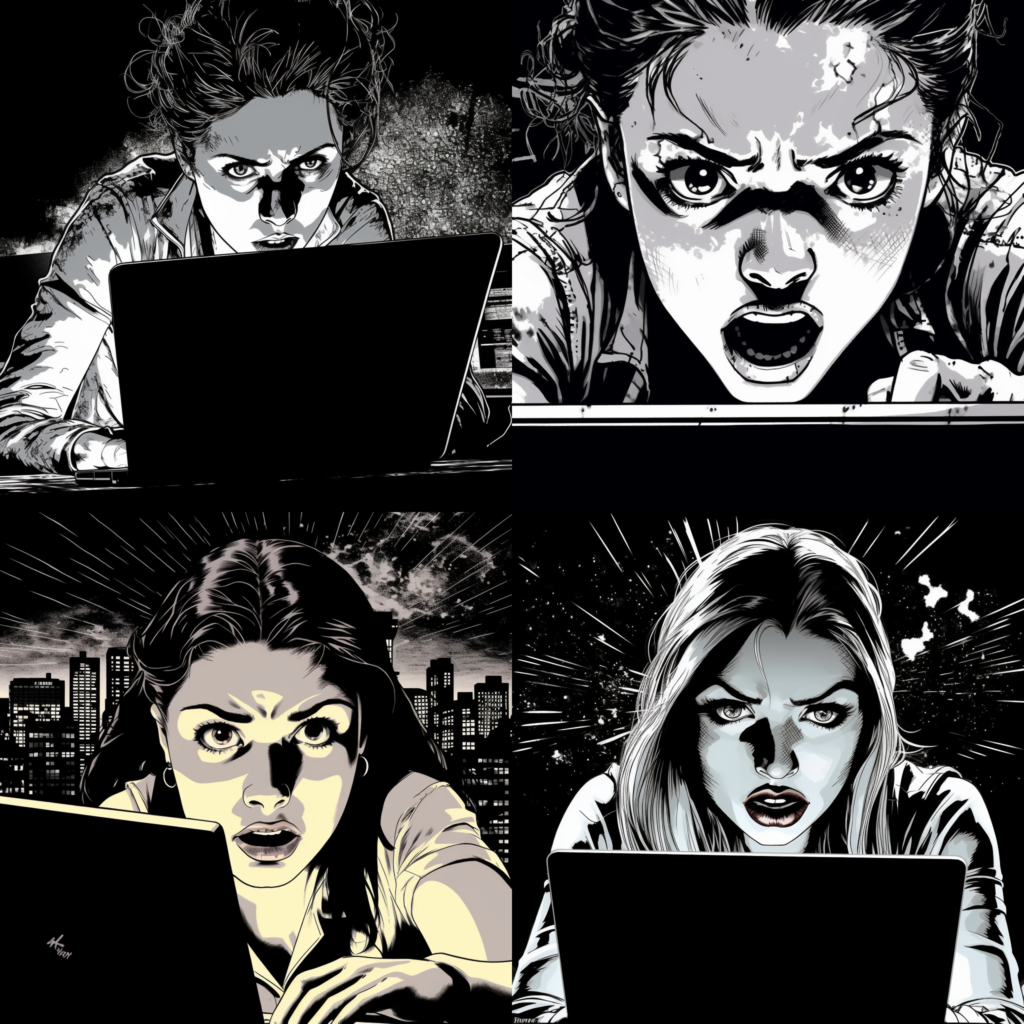
Frank Miller Sin City splash page, young entrepreneur angry about something she sees on her laptop –v 5.1 –style raw
2. Jim Steranko (1938-)
Another comic book artist, Steranko brought wild color and vivid imagery to a medium already brimming with both…and then took it to 11. Critic Les Daniels wrot “With each passing issue Steranko’s efforts became more and more innovative. Entire pages would be devoted to photocollages of drawings that ignored panel boundaries and instead worked together on planes of depth. The first pages…became incredible production numbers similar in design to the San Francisco rock concert poster of the period”. His style is noted both for experimental composition and bold, psychadelic colors.
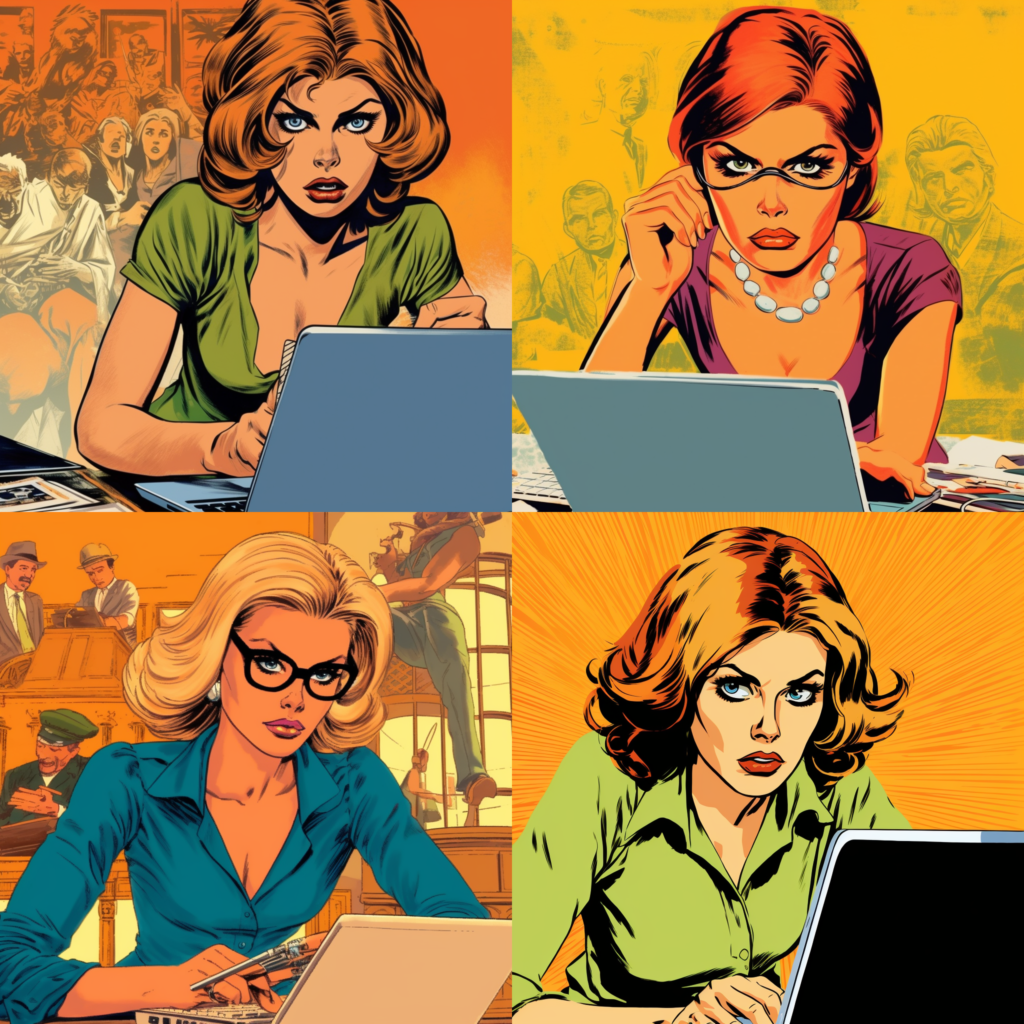
young entrepreneur angry about something she sees on her laptop in the style of Jim Steranko –v 5.1 –style raw
3. Robert Crumb (1943-)
Crumb was the subject of a famous documentary, sometimes called one of the best documentaries ever made. He was a prominent figure in the 1960s underground comics world and his detailed, heavily-crosshatched pen-and-ink drawings featured weird characters, anthropomorphic animals, and episodes from his own neurotic life. He’s been referred to as the “American Bruegel” for his expansive portrayal of the insanity of modern life.
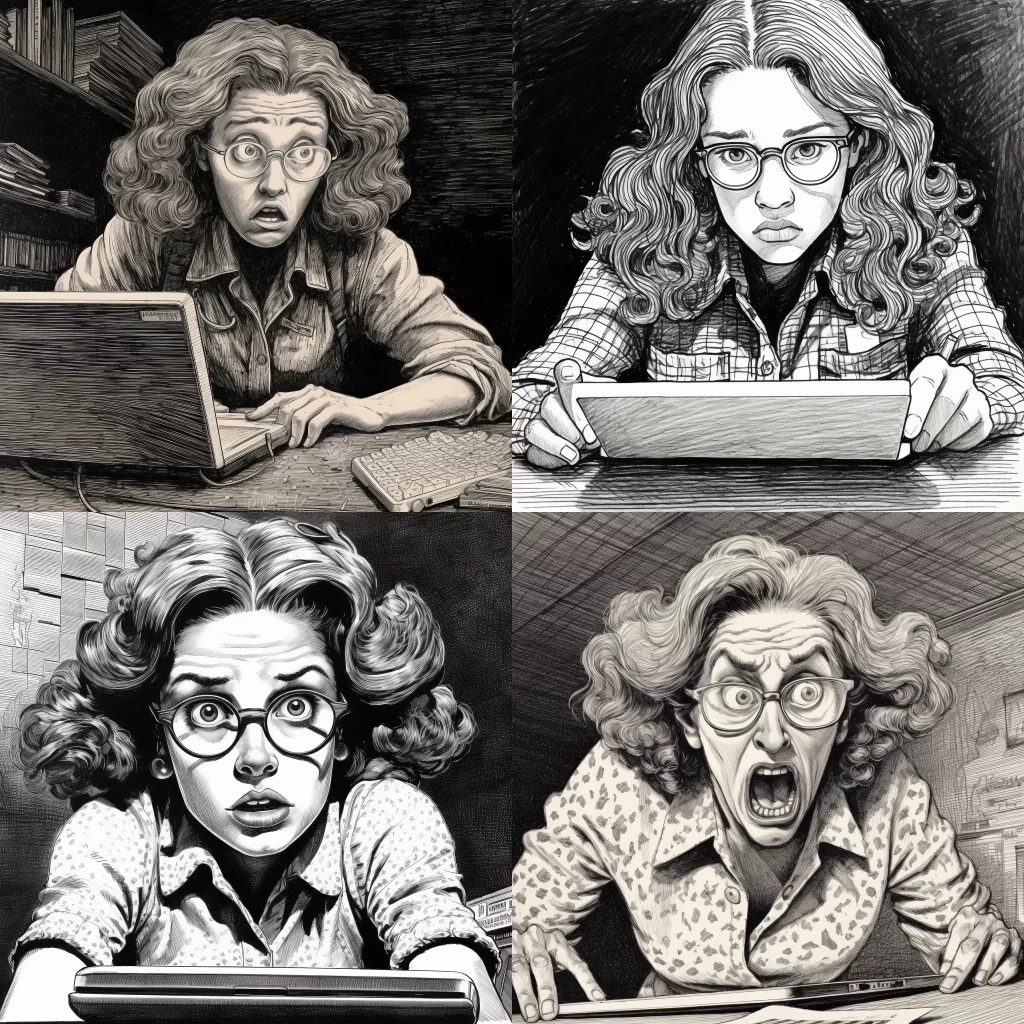
4. Norman Rockwell (1894-1978)
In 1916, the editor of the Saturday Evening Post bought a couple paintings from then-unknown Norman Rockwell and catapulted the young artist into fame. Over the subsequent decades, his work was often featured on the cover of the magazine. Rockwell’s portraits of traditional American life have a homey, folksy feeling to them, but they are executed with great detail and sharp rendering.
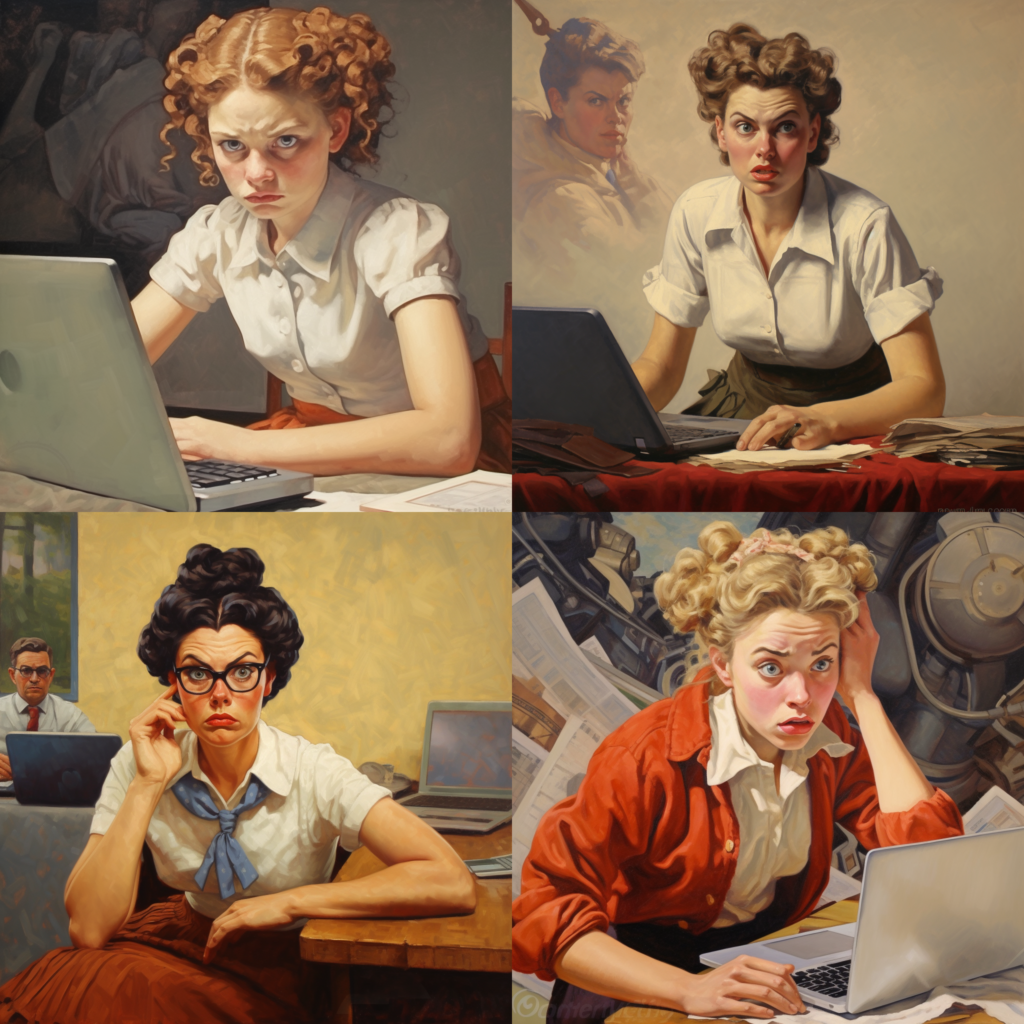
painting of a young entrepreneur angry about something she sees on her laptop in the style of norman rockwell –v 5.1 –style raw
5. Boris Vallejo (1941-)
Boris Vallejo is one of the first names that comes up if you try to make a list of famous fantasy artists. If you think of heroic fantasy art with swords and sorcery, biceps and sandals, odds are you’re thinking of Vallejo. His art has graced everything from fantasy and science fiction paperbacks to Heavy Metal magazine to the movie poster for National Lampoon’s Vacation.
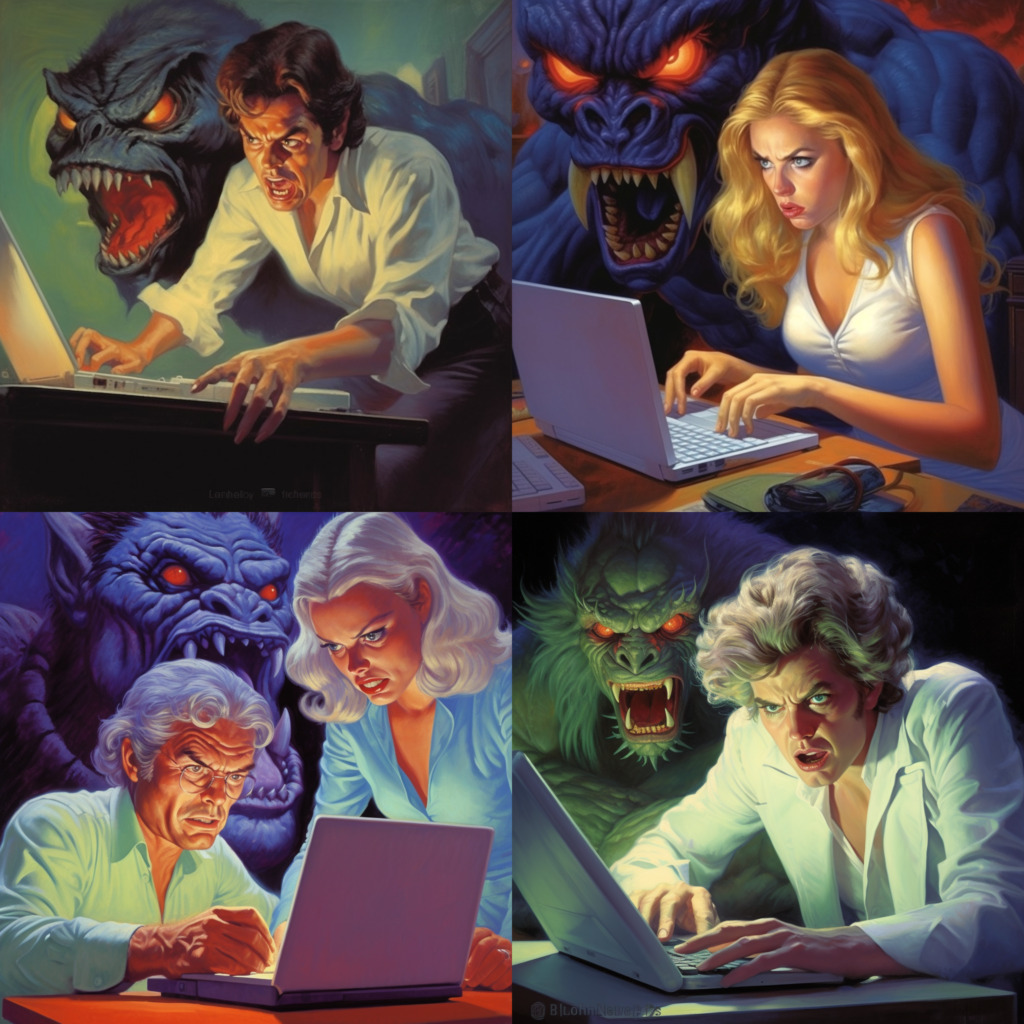
painting of a young entrepreneur angry about something she sees on her laptop in the style of boris vallejo –v 5.1 –style raw
6. Roy Lichtenstein (1923-1997)
If you’ve ever seen a comic book panel that looked like a parody of a soap opera, good chance it’s Lictenstein. One famous piece shows a woman’s face with swirling water, and a thought bubble that says “I don’t care! I’d rather sink than call Brad for help!” A pop art icon, Lichtenstein’s work is largely derivative of comic and other artist’s styles, reinterpreting them as comic, parody, or abstract pieces.

a young entrepreneur angry about something she sees on her laptop in the style of Roy Lichtenstein –v 5.1 –style raw
7. Alex Ross (1970-)
Most comics books are produced through a process of pencils, followed by ink, and then coloring and lettering. Ross rose to fame by painting entire comic books – for example, Marvels. Ross’s painting style is suited to heroic, soaring subjects – like superheroes.
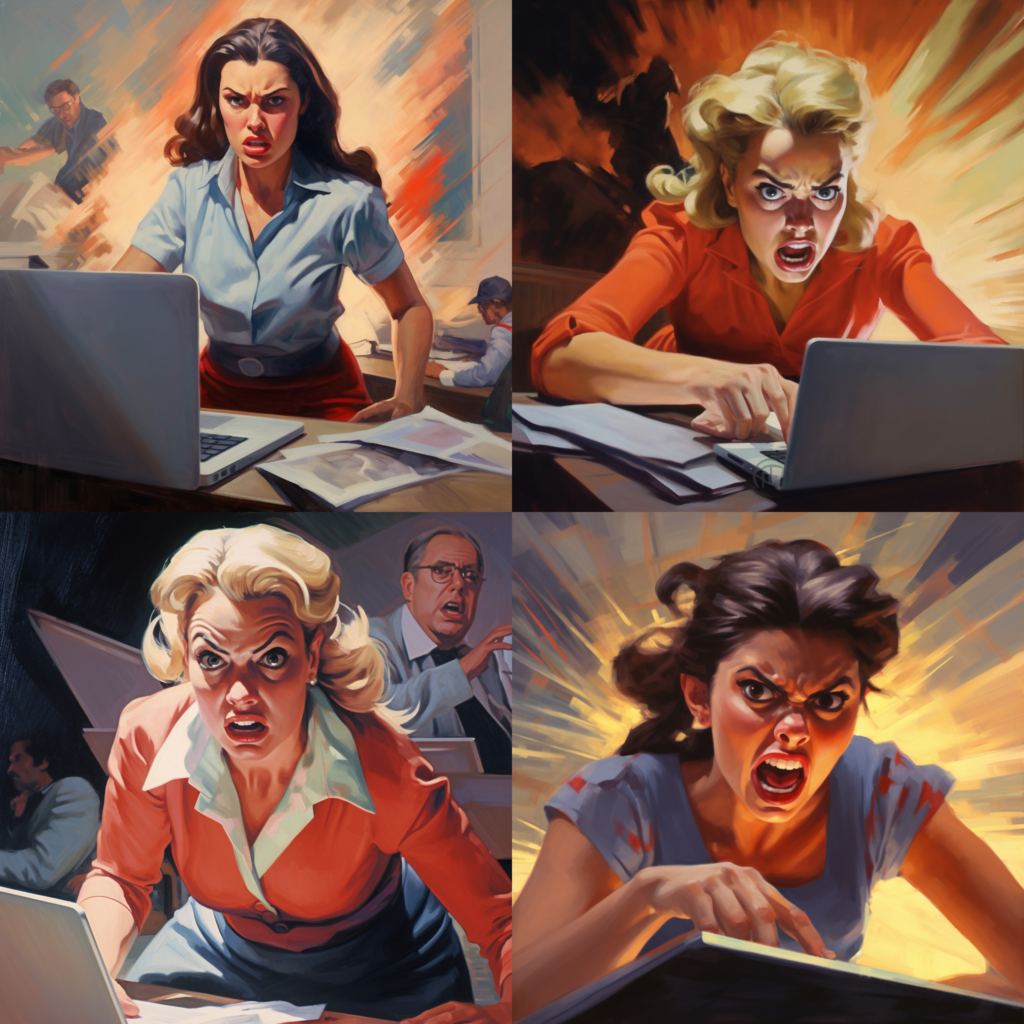
painting of a young entrepreneur angry about something she sees on her laptop in the style of alex ross –v 5.1 –style raw
8. Thomas Kinkade (1958-2012)
The “Painter of Light” (as he styled himself), Kinkade‘s work graces some of the finest dentist waiting rooms in America. His work has been described as “uber-kitsch” and “garish cottage paintings”. Although he made millions, his artistic vision rarely rose above starving artist landscapes. However, he understood his target – or at least his market – and his paintings had a sparkly brightness to them, done with a bright glowing palette that would not look out of place on a greeting card.
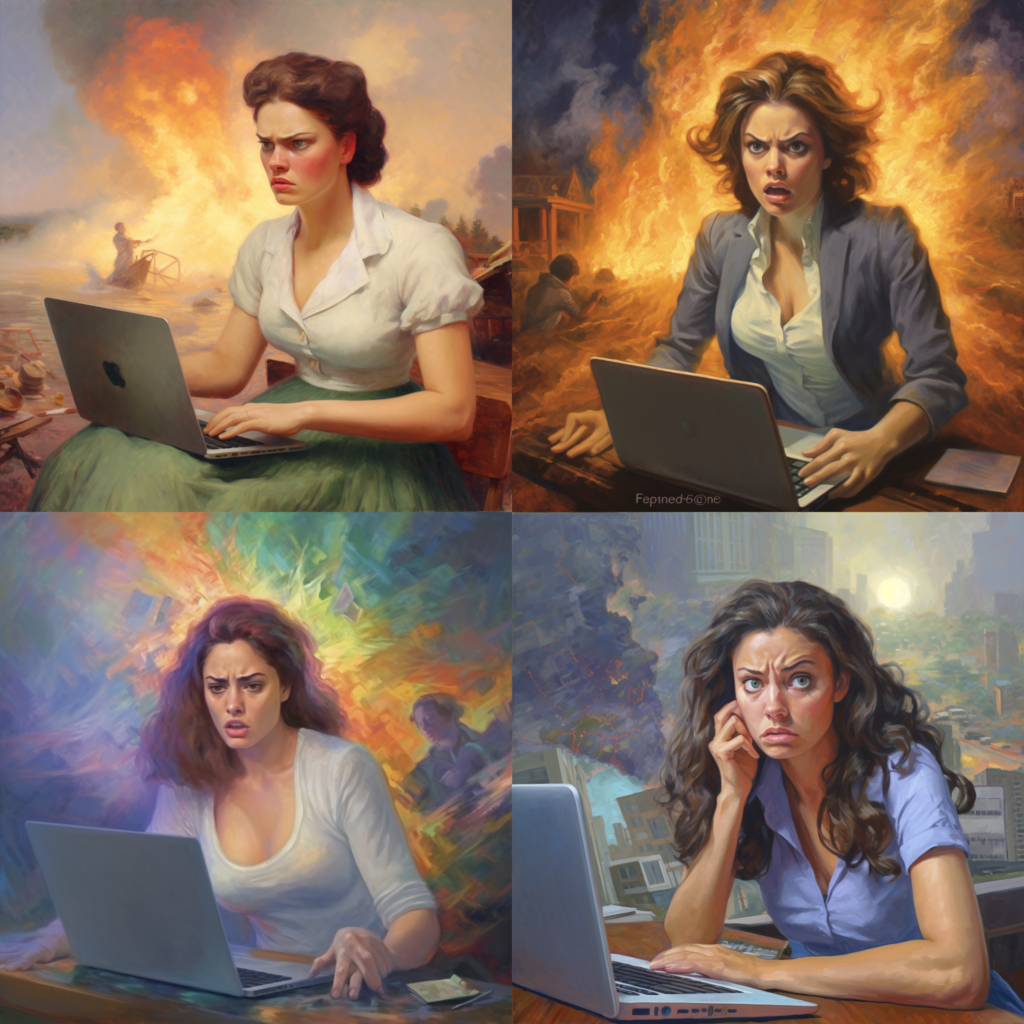
painting of a young entrepreneur angry about something she sees on her laptop in the style of thomas kinkade –v 5.1 –style raw
9. Larry Elmore (1948-)
If you ever played Dungeons and Dragons, you probably have seen some Larry Elmore art. He was a TSR employee back in the 80s and helped set the tone for their publications: exciting fantasy scenes depicting action and adventure, done with a broad palette of color and dynamic figures.

a young entrepreneur angry about something she sees on her laptop in the style of Larry Elmore –v 5.1 –style raw
10. Jack Kirby (1917-1994)
The man who invented Captain America, Fantastic Four, the Hulk, Ant-Man, Thor, Iron Man, the Avengers, the X-Men, the Silver Surfer, and the Black Panther – what more do you need to say about Jack Kirby! Easily one of the top if not the top comic book artist of all time. His artwork always showed tremendous action and motion, with his unique sense of strong storytelling and distinctive perspective.

a young entrepreneur angry about something she sees on her laptop in the style of Jack Kirby –v 5.1 –style raw
11. Dr. Suess (1904-1991)
Who didn’t grow up having Dr. Suess books read by their parents? Horton Hears a Who!, The Cat in the Hat, How the Grinch Stole Christmas!, Green Eggs and Ham, The Lorax, Marvin K. Mooney Will You Please Go Now! – the list just goes on and on. Each was filled with Suess’s flowing, easy-to-digest poetry and his cartoon illustrations, which look like nothing else ever printed.
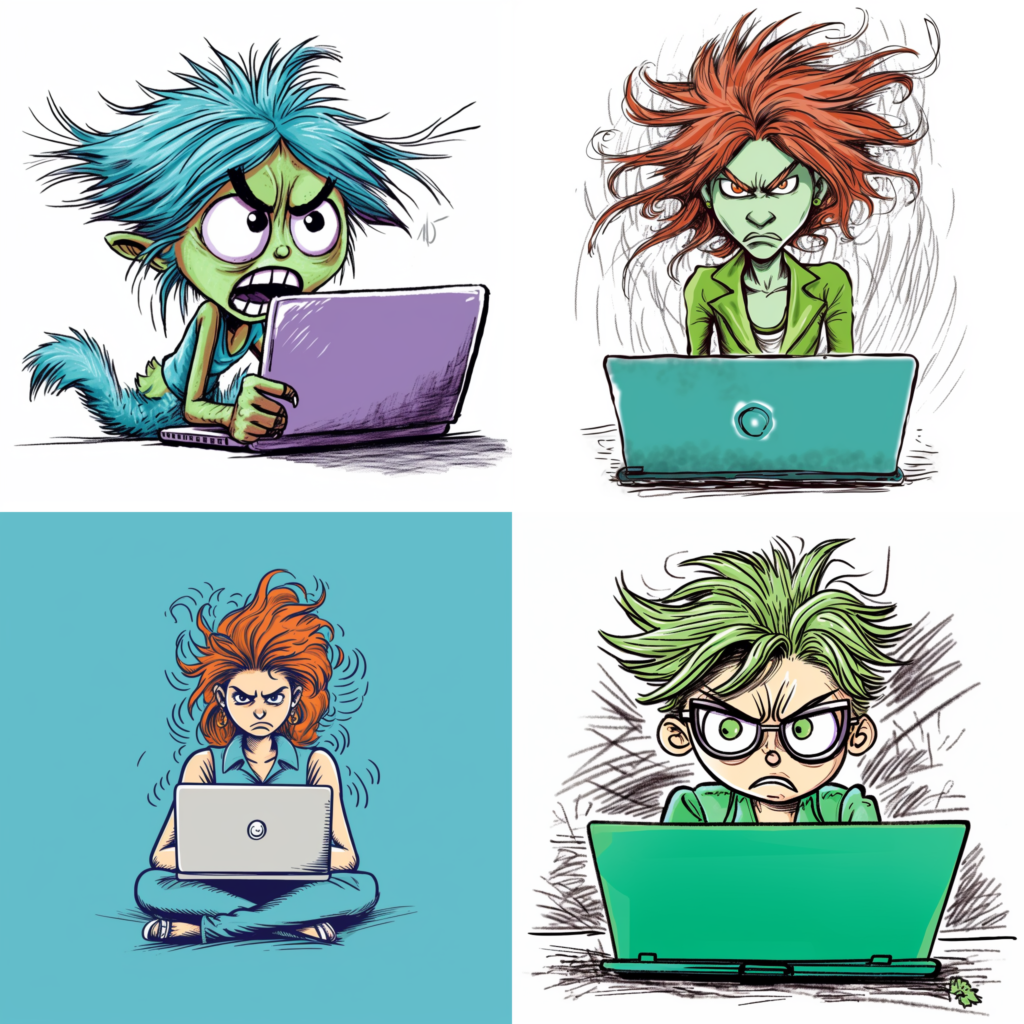
a young entrepreneur angry about something she sees on her laptop in the style of Dr Suess –v 5.1 –style raw
12. Simon Bisley
Another Heavy Metal magazine cover artist, Bisley began working in the 1990s and is entirely self-taught. His work has been featured by comic book publishers (both Marvel and DC), as well as numerous album covers, usually by metal bands such as Danzig (example).
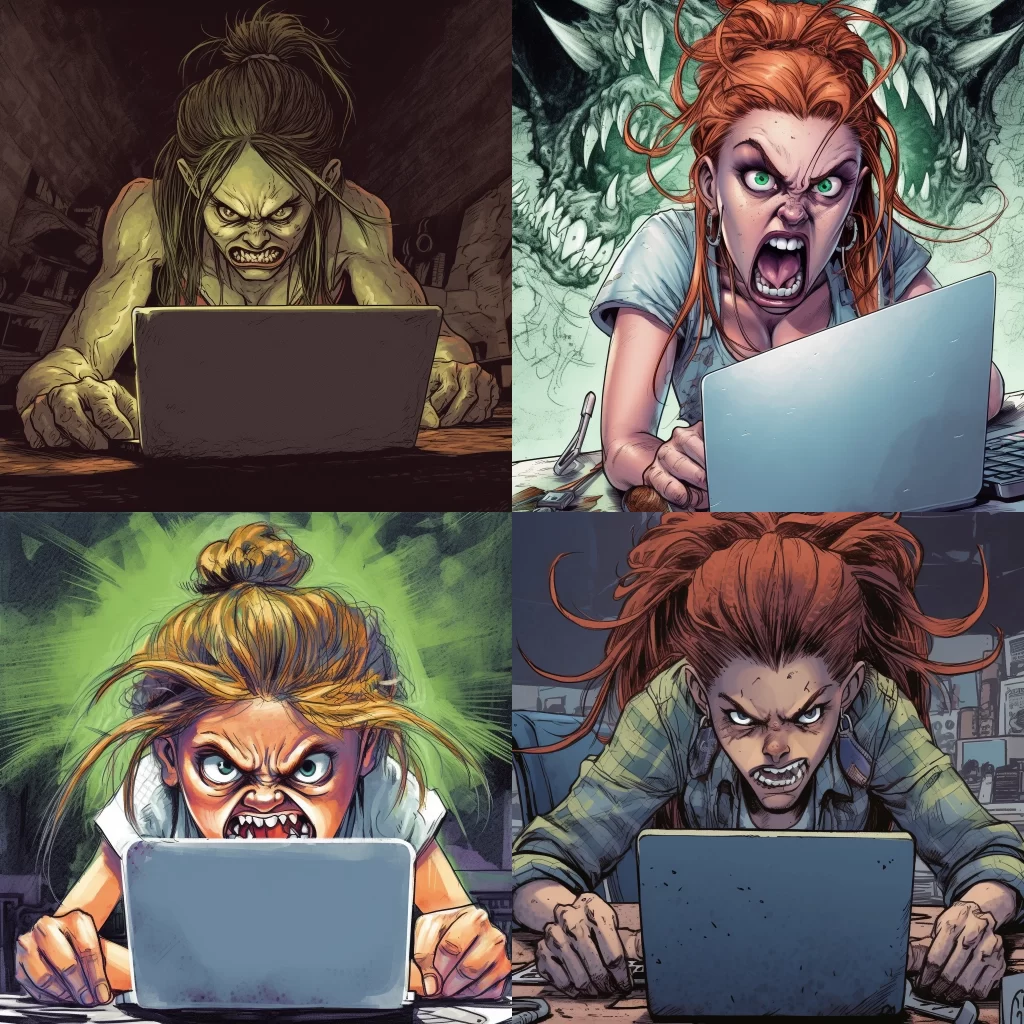
a young entrepreneur angry about something she sees on her laptop in the style of Simon Bisley –v 5.1 –style raw
13. Hubert Robert (1733-1808)
I’ve visited the Chicago Art Institute many times and one of my favorite rooms has four huge paintings by Robert. Each shows humans frolicking amid enormous ancient Roman ruins. They’re almost like post-apocalyptic paintings, as if the world had ended after the fall of the Roman empire. (To my knowledge, none of his actual paintings include a laptop).
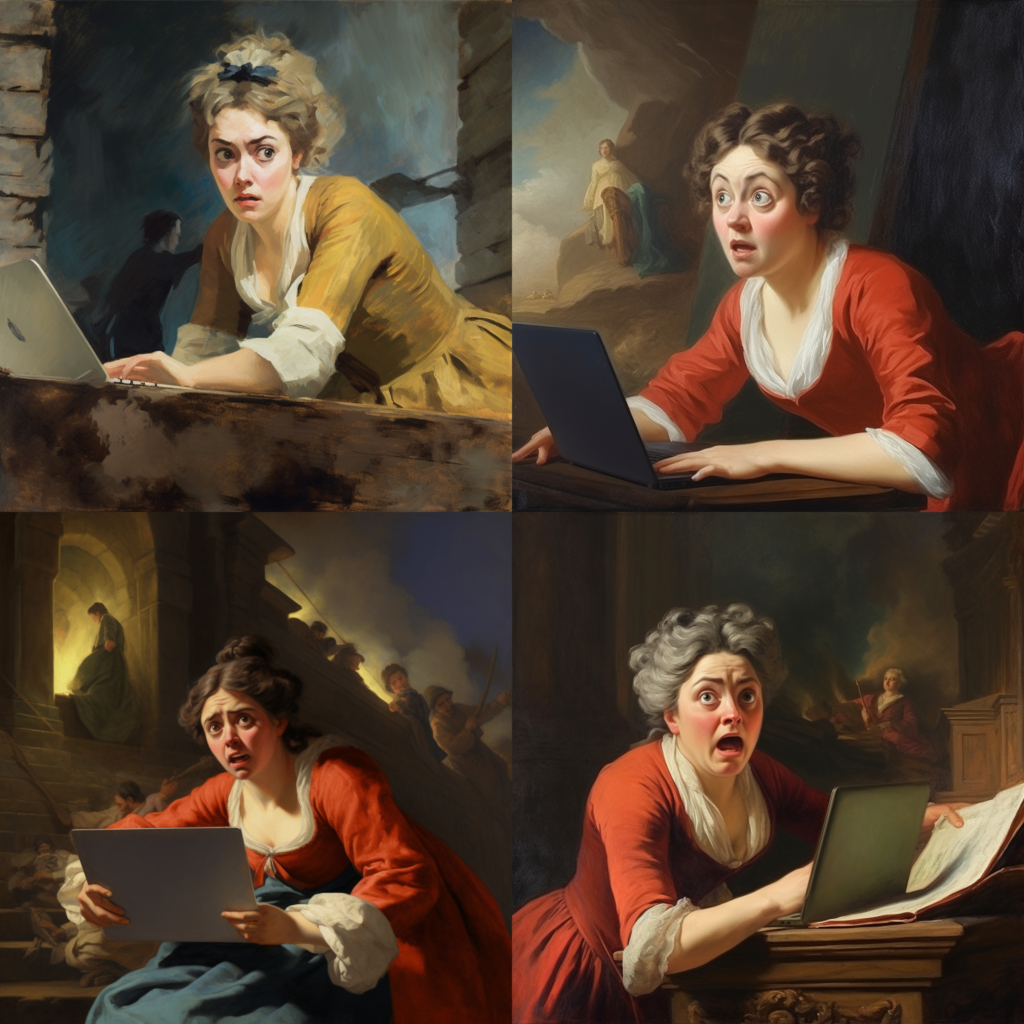
a young entrepreneur angry about something she sees on her laptop in the style of H. R. Giger –v 5.1 –style raw
14. H.R. Giger (1940-2014)
Remember the science fiction classic Alien? That’s Giger. His work shows terrifying aliens, weird organic pipes and machinery, and grim horror. If you’re looking for a truly scary alien environment, Giger’s your man.

a young entrepreneur angry about something she sees on her laptop in the style of H. R. Giger –v 5.1 –style raw
15. Jack Gaughan (1930-1985)
A prolific illustrator for fantasy and science fiction covers, Gaughan had a “broad visual vocabulary” which he used to create scenes set in everything from deep space to the Middle Ages. His artwork looks less like a wild imaginary scene than a textbook illustration of a wild imaginary scene.
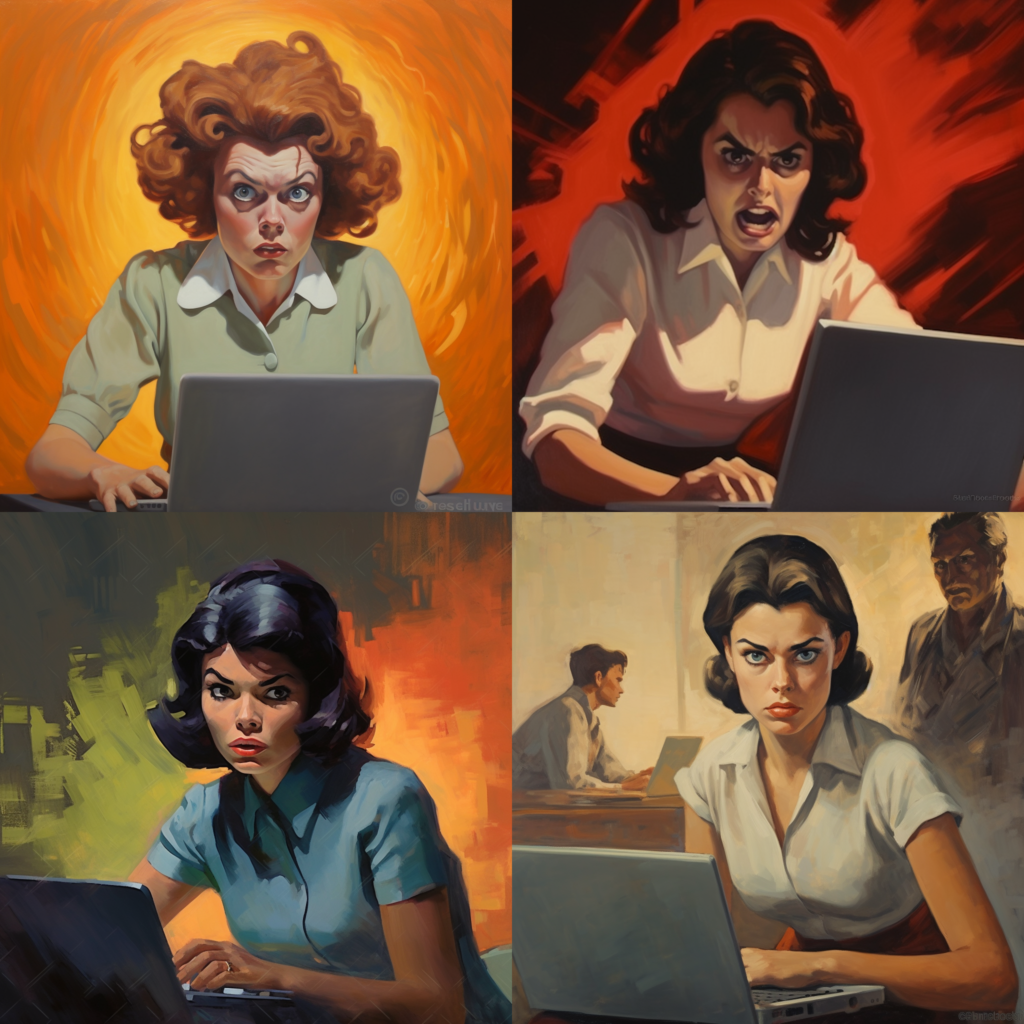
painting of a young entrepreneur angry about something she sees on her laptop in the style of Jack Gaughan –v 5.1 –style raw
16. Edward Gorey (1925-2000)
Wikipedia describes his work as “pen-and-ink drawings often depicting vaguely unsettling narrative scenes in Victorian and Edwardian settings”. Not entirely surreal but with a deep outré vibe, Gorey illustrated many children’s books. Think Tim Burton if Tim Burton had been a visual artist, and about 50 years earlier.
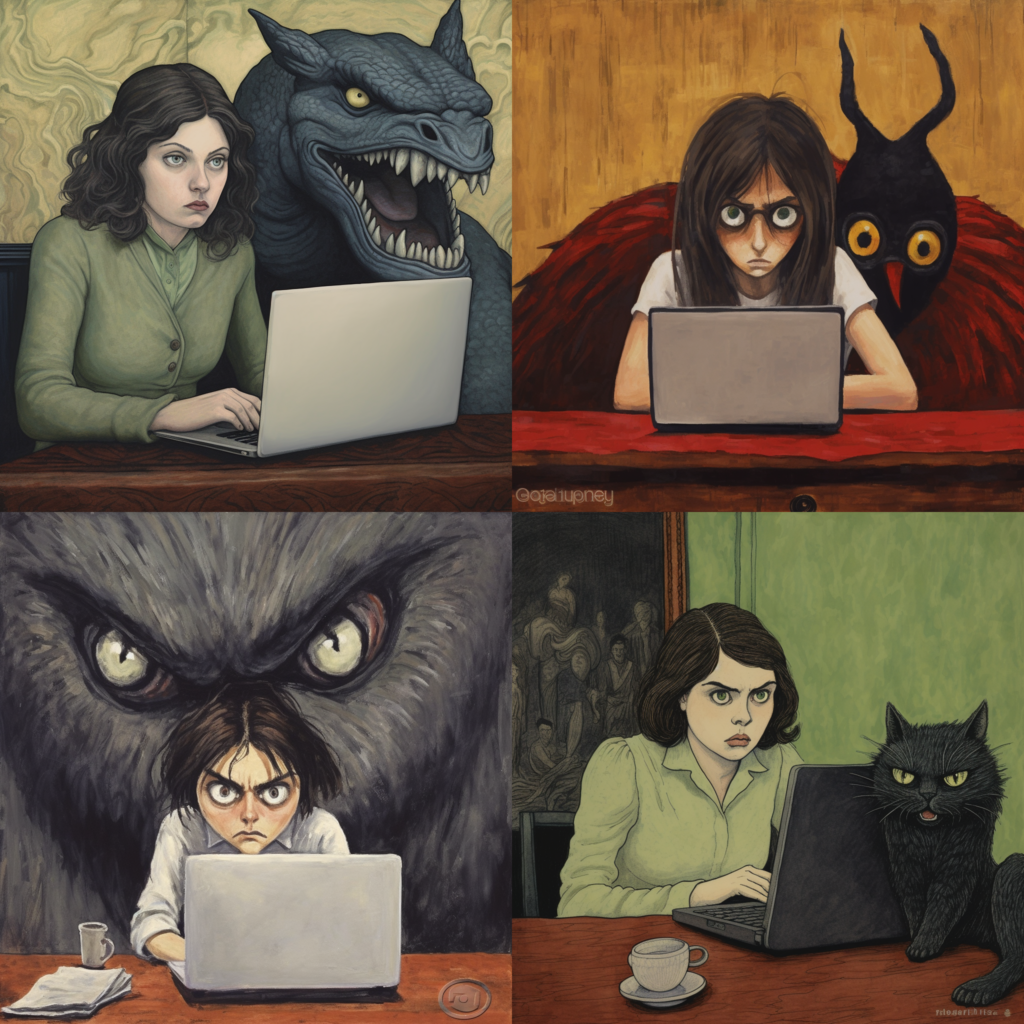
painting of a young entrepreneur angry about something she sees on her laptop in the style of Edward Gorey –v 5.1 –style raw
17. Patrick Nagel (1945-1984)
The 1980s was a time of cocaine, get rich quick schemes, fast cars, and Miami Vice. One of its best visual chroniclers was Patrick Nagel, whose work was featured on everything from Duran Duran album covers to Budweiser marketing. The “Nagel woman” is a distinctive high-fashion model with perfect cheekbones, lipstick, and a party girl look. Owing to widespread counterfeiting after his death, the FBI estimated in 1991 that his artwork hung in over 2 million homes.
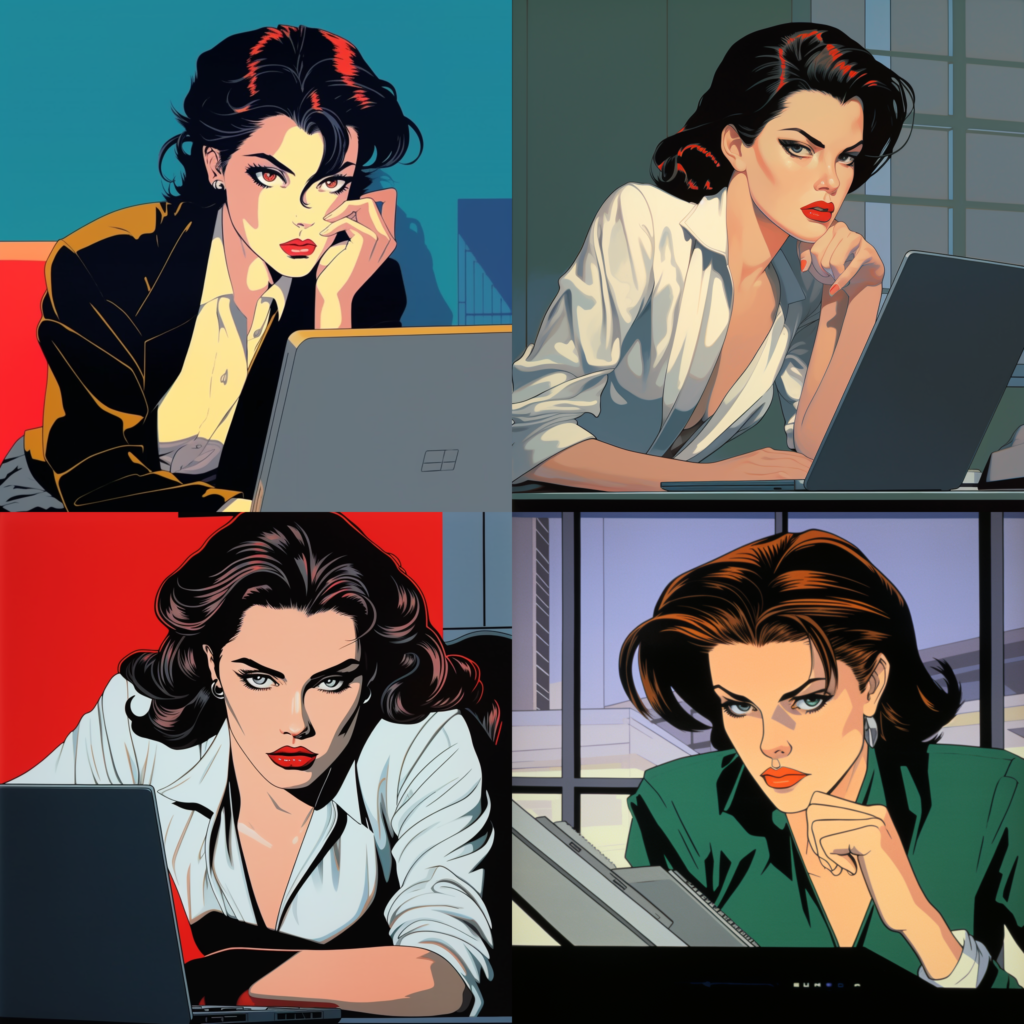
painting of a young entrepreneur angry about something she sees on her laptop in the style of Patrick Nagel –v 5.1 –style raw
18. Michael Whelan (1950-)
Another prolific science fiction and fantasy illustrator, Whelan has painted countless book and album covers (including this Meatloaf classic). His resume is full of covers for some of the most famous science fiction and fantasy authors of all time, many of whom spoke glowingly of his work.
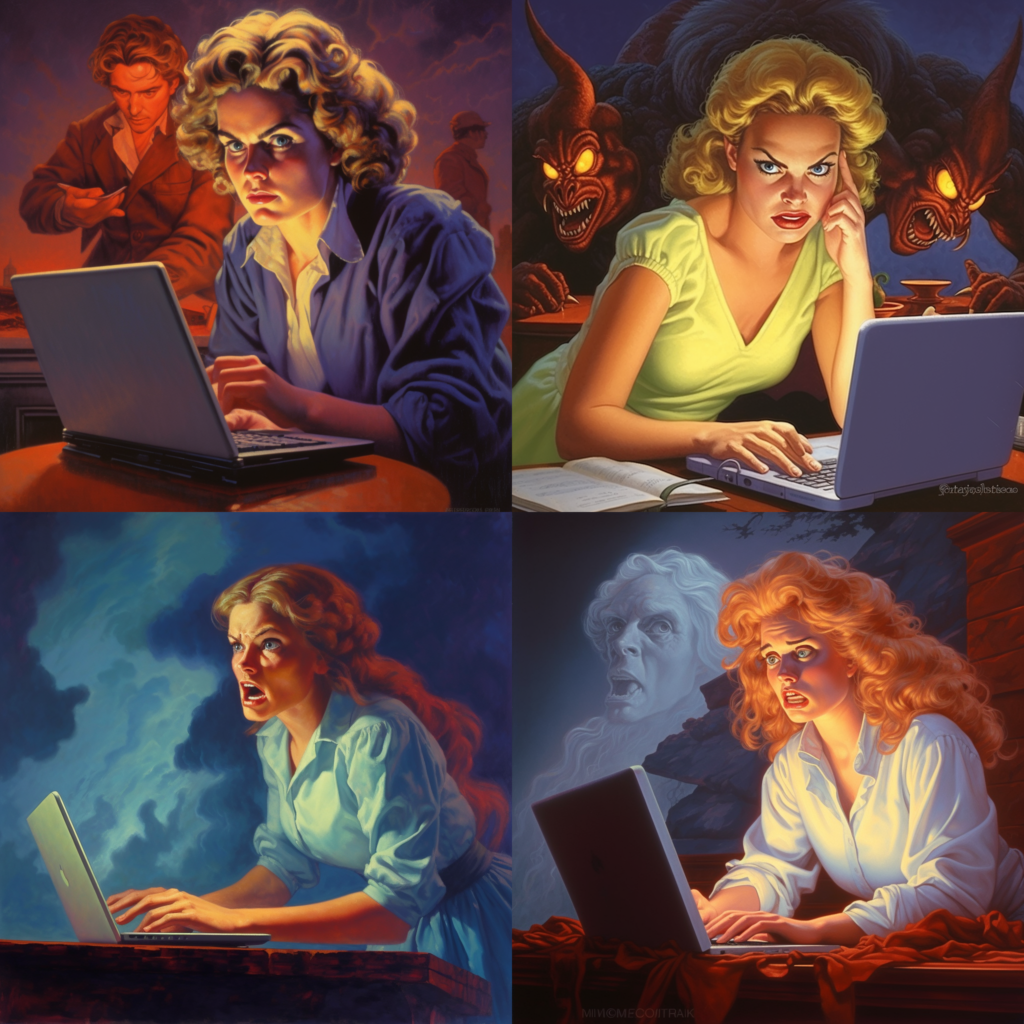
painting of a young entrepreneur angry about something she sees on her laptop in the style of Michael Whelan –v 5.1 –style raw
19. Scott McCloud (1960-)
Scott McCloud is the author of a trio of nonfiction comic books that educated a generation of readers and artists about comic books: Understanding Comics, Reinventing Comics, and Making Comics. If you’re looking to understand more about the medium, those are required reading.
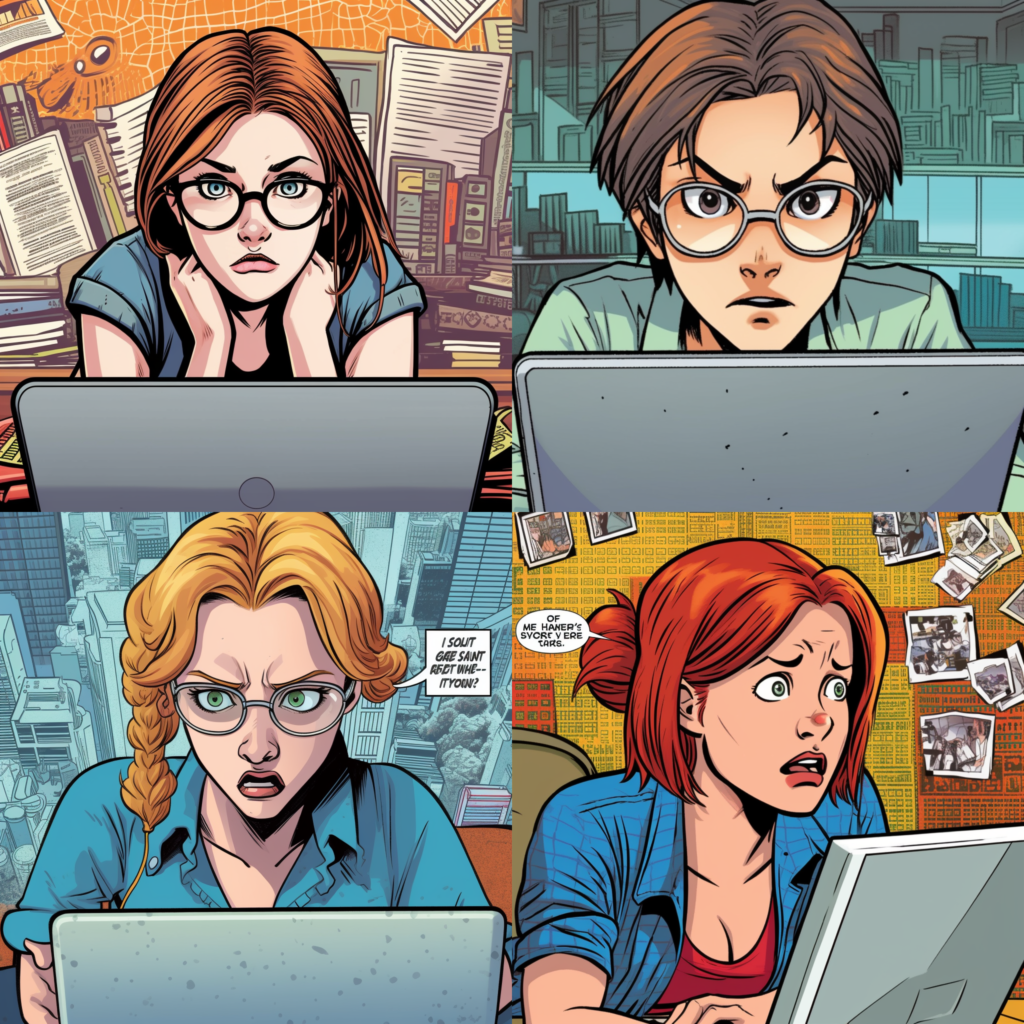
a young entrepreneur angry about something she sees on her laptop in the style of Scott McCloud’s Understanding Comics –v 5.1 –style raw
20. Bernie Wrightson (1948-2017)
Bernie is the guy who invented Swamp Thing, a long-running DC horror title. He also illustrated innumerable horror comics and illustrated novels. When comic legend Walt Simonson says he was in awe of Bernie’s work, you know Wrightson’s work is impressive.
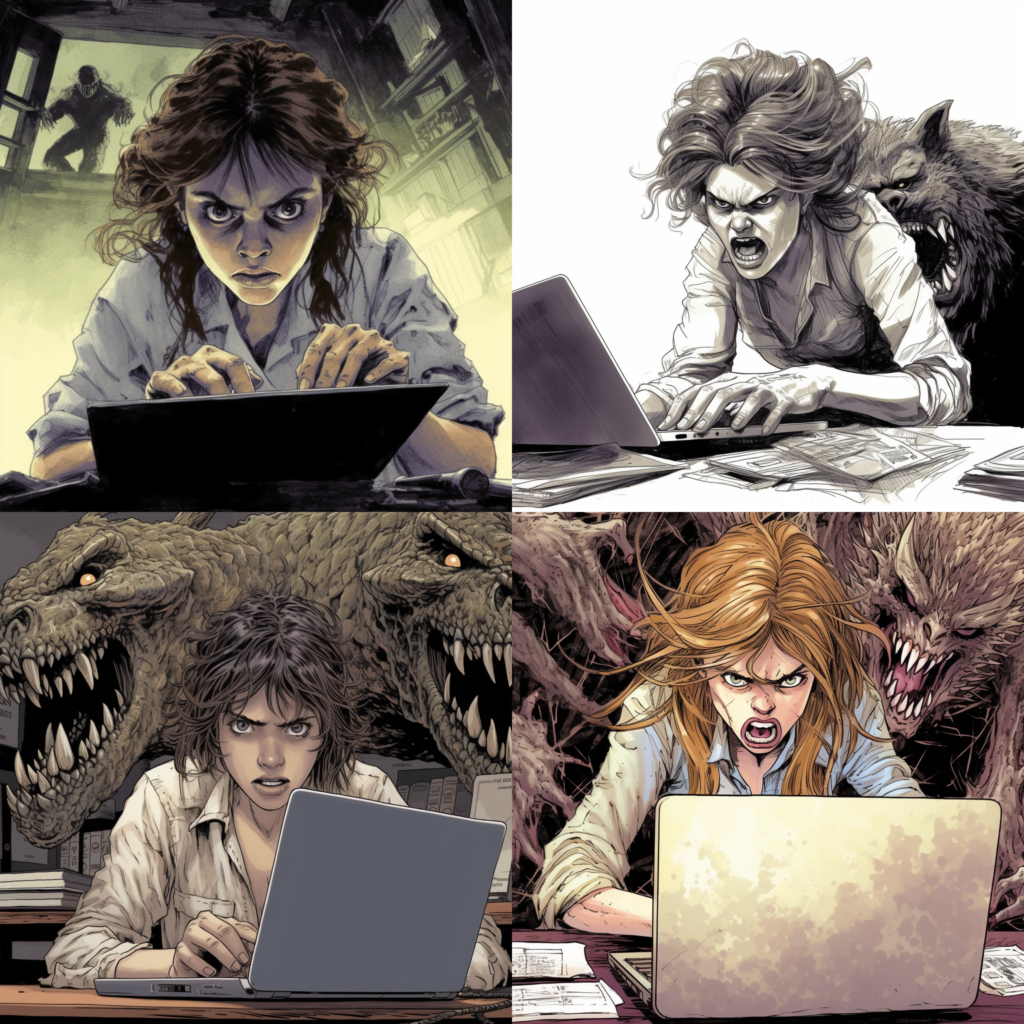
a young entrepreneur angry about something she sees on her laptop in the style of Bernie Wrightson –v 5.1 –style raw
And There You Have It
Have you played with Midjourney? What do you think of 5.1? Any other artist styles you rely on when you’re working on renders? Let us know in the comments below!























Leave a Reply